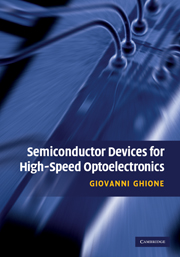2 - Semiconductor optical properties
Published online by Cambridge University Press: 03 February 2010
Summary
Modeling the interaction between EM waves and the semiconductor
The interaction between an electromagnetic (EM) wave and a semiconductor can be analyzed at several levels. EM waves can be described as classical fields (i.e., in terms of the electric and magnetic field) or, according to quantum mechanics, as a set of photons traveling with the speed of light. The crystal's response to the EM wave may be modeled in terms of macroscopic parameters such as the permittivity and permeability (the macroscopic picture of the interaction) or with reference to the microscopic interaction mechanisms between carriers and photons, leading to photon absorption or emission (spontaneous and stimulated) and, correspondingly, to electron–hole (e-h) pair generation or recombination (the microscopic picture). Moreover, we can look at the interaction between the EM wave and the semiconductor from two closely related viewpoints: the EM wave standpoint, yielding the wave absorption and gain, and the semiconductor standpoint, leading to the e-h generation and recombination rates.
Figure 2.1 presents a summary of the EM spectrum with decreasing energy and increasing wavelength. Two frequency (energy) bands are of main interest for highspeed optoelectronic applications.
The first band concerns the semiconductor sources, whose energy ranges from the near infrared to the UV (roughly 3 octaves, from 0.5 eV to 4 eV). Semiconductor energy gaps cover the same interval. The second band is the frequency range corresponding to radiofrequencies and microwaves (up to 40GHz) or even millimeter waves, up to 300 GHz, where the spectra of the modulating and/or detected electrical signals carried by an optical transmission system are found. Electronic devices and circuits for highspeed optoelectronic systems operate in this range.
- Type
- Chapter
- Information
- Semiconductor Devices for High-Speed Optoelectronics , pp. 52 - 103Publisher: Cambridge University PressPrint publication year: 2009



